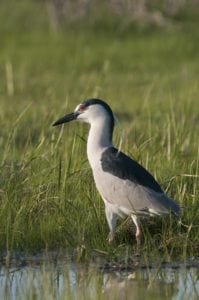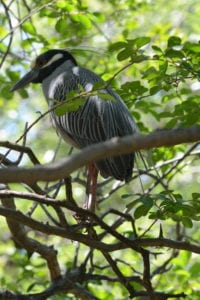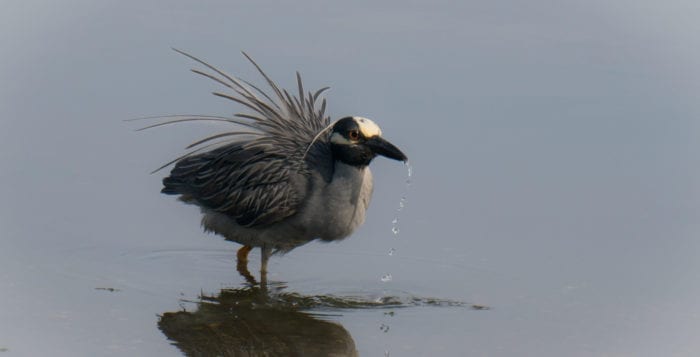By John L. Turner
If you like to spend time in early evening sitting on the southernmost bench at West Meadow Beach, enjoying the panoramic view of Stony Brook Harbor in the shadow of the Gamecock Cottage, you’ve probably seen or heard them. Feeding at the mouth of West Meadow Creek or along the main channel to the harbor or perhaps hearing their distinctive “wonk or quonck” call as one or more fly past. These are the night-herons and two species call the Three Village area home — the common black-crowned night-heron and the less common yellow-crowned night-heron.
They are called night-herons because of their habit of feeding most actively during sunset and into the night. This habit is reflected in their scientific names: Nycticorax nycticorax for the black-crowned night heron (nycticorax meaning “night raven” for their “wonk” sounding call they emit at dusk and through the night) and Nyctanassa violacea for the yellow-crowned night heron, meaning “a violet-colored night queen.”

On Long Island these two species inhabit the salty coast, rarely found away from the island’s salty brine environs. It is here they call home, feeding on the marine life that sustains adults and young alike. For black-crowned night-herons this means an assortment of fish, mussels, crustaceans, even the occasional mouse; whereas for the yellow-crowned it means almost exclusively crabs, which make up 90 to 95 percent of their diet. Fiddler and mud crabs beware! Because of their diet, night-herons, like owls, regurgitate pellets.
Watching them hunt is to observe a lesson in patience. With Zen-like focus they remain motionless or move very slowly through shallow water or along mud banks, essentially blending into the background so their prey no longer sees them for the predators they are. Then with a lightening strike it’s too late.
While they look similar, appearing as chunky wading birds lacking the grace of the egrets and great blue heron, they are easy to tell apart. The black-crowned has a “two-toned” quality with wings and a neck that’s gray with a dark back and crown. In contrast, the yellow-crowned is uniformly dark gray (sometimes casting a violet to purplish color as mentioned above) and has a distinctive and diagnostic white cheek patch, and a namesake yellow crown. Both species have long attractive plumes emanating from the back of their heads.
Identifying the juveniles, however, is more difficult. They both appear as chocolate brown birds with a lot of spotting. At closer glance there are clues to use to separate the species: the juvenile yellow-crowned has an all black bill while the young black-crowned heron’s bill is yellowish. Also, the yellow-crowned has a slenderer aspect to it with longer legs and finer spotting.

They nest in loose colonies often in association with other wading bird species such as snowy and great egrets. Young’s Island situated in the mouth of Stony Brook Harbor is a good place to observe these mixed species wading bird rookeries. The scruffy looking young are nothing short of comical looking with fine hairlike feathers splayed this way and that like the hair style of a mad scientist.
And it was scientists who realized they were declining many decades ago for the same reason that caused bald eagle, osprey, peregrine falcon and brown pelican populations to plummet — the widespread use of DDT, a persistent pesticide that affected the ability of birds higher on the food chain (those that eat animals) to produce eggshells. Fortunately, with DDT being banned by the EPA in the early 1970s, night-herons and these other species have largely recovered.
Interestingly, the effort to ban DDT began here in the Three Village Area when a number of local scientists like Charlie Wurster and Bob Smoelker, among others, joined with other concerned scientists to form the Environmental Defense Fund as a means to galvanize public support for banning the chemical. Now an effective environmental organization with an international reach, EDF began in the Three Village Area with the first office being on the second floor of the Stony Brook Village Center right behind the famous flapping bald eagle (likely the only eagle on Long Island at the time with no DDT in its tissues!).
You can bask in the glow of this good news of ecological healing as you sit attentive on that southward facing bench at West Meadow Beach, waiting for the herons of sunset to appear.
John L. Turner, a Setauket resident, is conservation chair of the Four Harbors Audubon Society, author of “Exploring the Other Island: A Seasonal Nature Guide to Long Island” and president of Alula Birding and Natural History Tours.





